On Saturday, Manmohan Singh left for Washington. The Indian prime minister’s four-day visit gives the struggling Obama administration an historic opportunity to further ties with New Delhi — and to erase the failures of the president’s recently completed trip to Asia.
And there is much to erase. Let’s start with all the bowing. Obama’s bow to Japan’s Emperor Akihito received so much attention, but the president performed the same act in China, stooping low to Premier Wen Jiabao, the Communist Party’s No. 3-ranked leader. Wen, not even a head of state, received the bend-at-the-waist treatment from the president during their meeting in Beijing, as did some low-level functionary in Shanghai at the now-infamous town hall meeting. Shall we call him “Barack Bowbama”?
So was the bowing significant? The obsequious acts during both stopovers in China were, unfortunately, indications of Obama’s submissive attitude toward the Chinese communist state. Before getting on the plane for Asia, the American leader performed two figurative bows to Beijing. First, he refused to meet with the Dalai Lama on His Holiness’s trip to Washington early last month, breaking a practice of the previous three administrations. Then, in a Reuters interview on the eve of the trip, Obama said the United States and China were bound together in a “strategic partnership,” something Beijing has been waiting a decade to hear.
Despite his pre-emptive concessions, the president received little in return. The Chinese, pocketing these gains, seemed to have stiffed Obama on every issue under discussion in Beijing. The White House afterwards issued a “U.S.-China joint statement” listing areas where the two nations agreed to cooperate, but the document seems as if it was patched together to paper over differences evident during the meetings in the Chinese capital.
Not even Obama’s soaring words about cooperation and shared interests could hide the fact that Hu Jintao, his counterpart, and Premier Wen did not budge on anything of significance, especially their pegging of the renminbi to the dollar, which is the main obstacle to sustained global recovery. Pundits say that the next few months could reveal a more cooperative China when, for instance, the question of Iran lands back in the Security Council, but there was no indication during the terse post-summit appearance in Beijing on Tuesday that the two countries had made progress in coming to terms.
Part of the reason is that the Chinese positions on these controversies are so different than America’s. Yet Beijing can be moved in constructive directions — but only when American diplomacy is tough and principled. Unfortunately, under Barack I-will-kneel-to-any-nearby-autocrat Obama, our policies are anything but.
For one thing, Obama gives the impression that he is above the Chicago street-style politics that the Chinese leadership practices. Instead, the former community organizer seems to have accepted the notion that the Chinese can be flattered into cooperation. Unfortunately, all Obama’s talk of the importance of China is having the opposite effect. When Jeffrey Bader, the president’s chief East Asia hand at the National Security Council, says China is an “essential player” and that none of the great issues of the day can be solved “without China’s cooperation,” the Chinese begin to think they have a veto over American policy. In these circumstances, they of course feel they can exact any price for their assent. Our approach to China, therefore, is undermining our goals, not furthering them.
None of this unhelpful rhetoric might matter if Obama had rallied Asians to balance an assertive China. He had the opportunity to do that on this trip during stopovers in Tokyo, Singapore, and Seoul, but he missed these chances. Instead of projecting confident American leadership, he let Asians think he is not up to standing firm against the increasingly arrogant Chinese.
That’s why Manmohan Singh’s visit to Washington offers a crucial second chance for Mr. Obama. The Indians understandably worry that the president is showing a tilt — as well as a bow — to their arch adversaries, the Chinese and the Pakistanis. Obama, to his credit, has reserved his first state welcome to Singh, who he considers as “part of his family.” There will be a state dinner on Tuesday.
And ties between America and India should be that close. There are, to be sure, fundamental differences between the two nations. Don’t expect important agreements on climate change, nonproliferation, or trade. Yet two important democracies should be able to set aside disagreements and realize that their interests are — and should be — tied together in the long run. For one thing, both nations face challenges from the same authoritarian giant on the mainland of Asia. And when Chinese leaders see New Delhi and Washington growing closer, they will surely be more cooperative than they are at this moment.
If there is to be a G-2 in the world, it should not be the United States and China. It should be the world’s most populous democracy and its most powerful one. That’s an alliance we can believe in — and, in future years, one that we will depend upon.









Join the conversation as a VIP Member